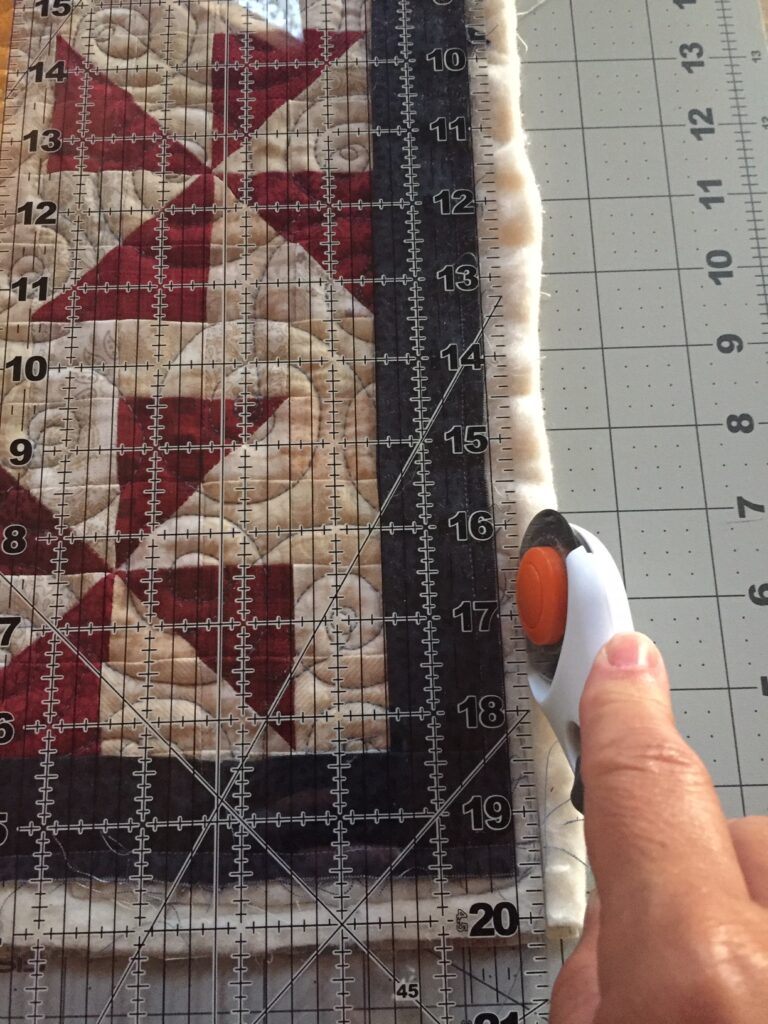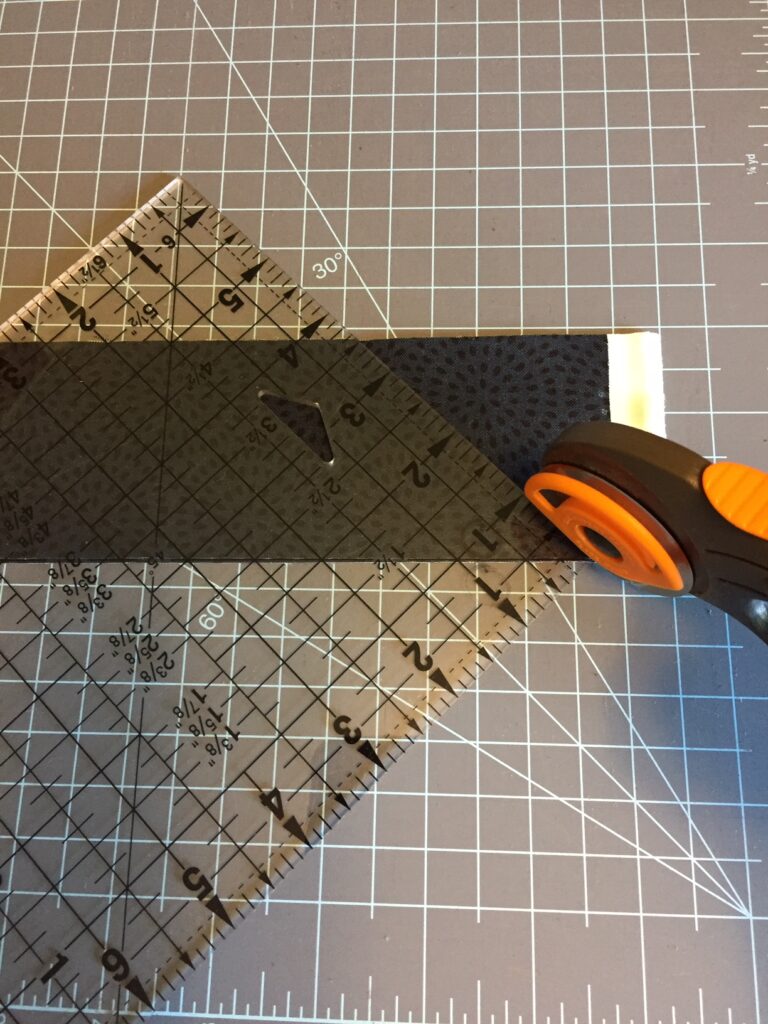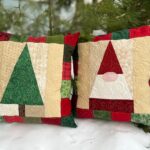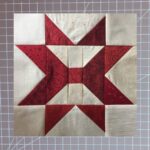This scrappy, mini Pinwheel Party quilt is an easy pattern for a beginning quilter. Measuring just 12” x 12”, this quilt is the perfect size to decorate a shelf or table. Or add a sleeve to the back of the quilt, and hang this party up!!
There’s nothing complicated about the pattern. This quilt can easily be over the weekend!! Using such small squares, you can either purchase small amounts of fabric or just use scraps to create this fun project!
These pinwheels totally remind me of summer! I can remember playing with pinwheels as a little girl. Such simple fun!!
I made mine a patriotic Pinwheel Party Quilt just in time for the 4th of July!
But you can make these pinwheels in any color palette!!! They’d be pretty in pastels with each pinwheel a different color. White or cream pinwheels with a colored background would look great too! The sky is the limit!!! Use your imagination and have fun making this super easy pattern!
This quilt has been featured in an article published by ALLFREESEWING, “21+ Gorgeous Quilt Patterns (for free)”. You’ll find two of my quilts in this article, along with other beautiful free quilt patterns!!! I just love finding beautiful, free quilt patterns, don’t you???
All directions for this little quilt are included below.
If you’d like to purchase an ad-free pdf of the pattern, visit the lakegirlquilts Etsy shop by clicking here!
Post contains affiliate links and we earn commissions if you shop through the links on this page. For more information please read the disclaimer on the Privacy Policy page.
General Sewing Directions
The directions for this Pinwheel Party quilt are for rotary cutting, machine piecing, machine quilting, and the binding is hand-stitched to the quilt back.
Accurate cutting and sewing enhances your final product. Pin your pieces together before sewing them to ensure proper seam alignment.
Use a ¼” seam allowance. I recommend using a special presser foot with a ¼” guide if you have one for your machine. This will help you get uniform seams, and matching corners!
Follow the directions described below as you press open the seams. Each individual row is pressed in the opposite direction of the previous row to eliminate bulk and help seams to lay flat. Rows sewn together are then all pressed in one direction for a uniform look.
The pattern calls for machine quilting, but this quilt is so small you could easily hand quilt it!
The finished quilt measures 12” x 12”.
This scrappy, mini Pinwheel Party quilt is so cute it’ll make your heart spin! It takes very little fabric to make this quilt. Carefully read through all the information below on how to create this little, scrappy beauty!
Fabric Requirements
The pinwheels are created using a variety of red prints. For the background I used a variety of buttery cream-colored fabric to show off the pinwheels. I also added a little blue to each corner as a fun frame, and used blue for the binding to help make the red pinwheels pop even more! Have fun choosing your color palette, and remember…there are no rules!!
Red Fabric:
The total fabric needed is less than ¼ yard. However, to achieve the scrappy look of this quilt I suggest using at least 8 different prints. Either raid your stash, or purchase a few new fat quarters. You’ll need at least a 1 ½” wide strip of any one fabric.
Blue Fabric:
You’ll need a less than ¼ yard. Use 4 different prints.
Cream Fabric:
Again, the total fabric needed is less than ¼ yard. However, to achieve the scrappy look of this quilt I suggest using at least 8-10 different prints. Either raid your stash, or purchase a few new fat quarters. You’ll need at least 1 ½” wide strip of any one fabric.
Backing Fabric:
1 fat quarter
Binding Fabric:
1/6 yard total
Batting:
You’ll need a piece of 14″ x 14″ thin cotton batting (like Warm & Natural) to make this quilt.
Cutting Directions
If you need tips on using a rotary cutter, click here for one of my previous posts!

Pinwheels:
Cut a total of 48 – 1 ½” red squares. I suggest using at least 8 different prints.
I used 8 different red prints and made each blade of my pinwheel from a single fabric. Two blades among the four pinwheels have the same fabric. But you could use several different fabrics to make a blade.
Each of the five full pinwheels consist of 12 red squares. Each blade of the pinwheel consists of 3 red squares.
Either raid your stash, or purchase a few new fat quarters.
Corners:
Cut 12 – 1 ½” blue squares.
You’ll make half square triangles from some of these squares. I used 4 different blue prints.
Background:
Cut 124 – 1 ½” cream squares. Again, use a variety of at least 8-10 different prints from your stash or fun new fat quarters. I actually used 12 different cream prints in my Pinwheel Party.
You will use 40 of these squares to make half square triangle blocks.
Binding:
I used a dark blue print for my binding. In total, you’ll need a binding strip that ends up measuring about 60” long (this leaves room for connecting and trimming the ends). Cut either 2 – 2 ½” x 44” strips, or cut 4 – 2 ½” x 22” strips, trim the ends of each strip at opposing 45-degree angles.
Backing:
Cut a 14” x 14” square
Batting:
Cut a 14″ x 14″ square
Making the Half Square Triangle Blocks
You’ll use 1 full red square and 2 red/cream half square triangle blocks to obtain the shape of the pinwheels.
You’ll use 1 full blue square and 2 blue/cream half square triangle blocks to make the corners.
In all, you’ll need 32 red/cream half square triangle blocks and 8 blue/cream half square triangle blocks. Follow this process to create each of the half square triangle blocks needed.
Choose 40 of the cream squares and 32 red squares (I made mine in sets of four of the same red fabric). Also choose 8 of the blue squares (I made mine in sets of two of the same blue fabric).

Using a fine pencil, lightly draw a diagonal line on the wrong side of each of cream square. Now, place the right side of a red block and the right side of a cream block (the one you just drew the line on!) together. With the diagonal line facing you (wrong side up!), sew along the line. Trim ¼” from seam. Press open toward the colored side. This half square triangle block should again measure to be a 1 ½” square. Trim if needed.
I’m sorry I didn’t take any more pictures of making the half square triangles. Here’s a previous post with pics of how to make a half square triangle!
Repeat for all red/cream and all blue/cream half square triangle squares.
Assemble the Pinwheel Party Quilt Top
Now that you have all your 1 ½” squares cut out and your half square triangle square blocks ready, you want to plan how they’ll be arranged to make up the Pinwheel Party quilt top.

I like to lay all my squares on a card table next to my sewing machine and play with arranging them until I get the look I want. The layout will be 12 squares across and 12 squares down.

The quilt top has 12 rows. Begin stitching squares together (right sides facing) to complete each row. Remember to use a ¼” seam allowance for all seams. I really like to use my ¼” seam foot to make sure all my seams are exactly ¼”!! This is especially important when sewing such tiny squares together. If you don’t have this type of foot, make sure you know exactly where your ¼” sewing line is on your machine, and be careful to follow it!
As you complete a row, lay it back down on the table in the right placement to make sure you don’t mess up your arrangement of blocks.
Pressing the Blocks and Rows
I wait to press the rows until I have each of them sewn together. Be careful to just “press” and NOT “iron” the seams in a back-and-forth motion, or your quilt will stretch out of shape.

Begin by pressing the seams of the first row all in one direction. Press the seams of the second row in the opposite direction. Continue to rotate the pressing direction of each row until you have the seams of all rows pressed. Think…odd rows 1, 3, 5, etc. press the seams to the right. Even rows 2, 4, 6, etc. press the seams to the left.
By using this rotating direction of pressed seams, you will have nicely nested seams and less bulk when you sew the rows to each other.

This method of pressing distributes the bulk, which will make you happy when machine quilting your project! Bulky seams can lead to bumpy quilting patterns, broken thread, and overall unevenness of your machine-quilted quilt top.
Now that you have the pieced rows pressed, sew them together! Pin rows 1 and 2 together, right sides together. Make sure to line up the seams, and pin to hold them in place.

Remove the pins as you come to them when you’re stitching the ¼” seam. I like to press each set of rows as I sew them together. The rows all get pressed in one direction, either towards the top or towards the bottom. By pressing them all in one direction it will make for a uniform and smooth quilt top. Repeat until you have all of the rows sewn to each other and pressed.

Finishing the Pinwheel Party Quilt
Now that you have your quilt top sewn together, it’s time to finish it!
Layering the Top, Batting, and Back
I refer to layering the quilt as “sandwiching”. You need to sandwich the top and back with the batting in the middle. For a larger quilt, this process takes a bit more time and steps. But for this mini quilt, it’s a breeze to sandwich the layers together!
On a table or countertop, use masking or painter’s tape to tape down the backing fabric. As you tape the back to the table, you’ll want to make sure the fabric is smooth, without wrinkles. Also, make sure the right side of the fabric is facing down!
Lay the batting on top of the taped-down quilt back, and move your hands across it to smooth it all over. This will get rid of any wrinkles in the batting, and help to adhere it to the backing fabric. This quilt is so small, you don’t need to use basting spray to adhere the layers together. Just a few pins will do the trick!
Once you have the batting placed on top of the quilt back, center the top of the quilt (the flimsy!) over the two bottom layers. Right side facing up, of course! The two bottom layers of the quilt (the back and the batting) should extend about 2” all around the outside edges of the quilt top.
Basting the Pinwheel Party Quilt Layers…
Move your hands across the quilt top to smooth it all over, and help remove any wrinkles. This will also help adhere the quilt top to the batting a little bit. Once you have the top of the quilt all smoothed out, use large safety pins to baste all three layers together. I like to use 1 ½” stainless pins, and I keep them all in a cute old canning jar that was my grandma’s.

Put a pin in each corner of the quilt sandwich, in the middle, and around the quilt so the three layers don’t move around when machine quilting this project. I used about 8-10 pins to hold the sandwich together. You really don’t want to use more than this or you’ll be needing to stop a lot when you’re quilting to remove pins, which upsets the mojo of your quilting rhythm, lol!
“Quilting” the Quilt
I used blue thread and a cute swirly cinnamon bun pattern to machine quilt my Pinwheel Party layers together. I think it looks like the wind blowing the pinwheels!
Use whatever free-motion stitch you’d like, or use a straight stitch to quilt in the ditches or along the seams. You’ll need a darning foot to free-motion quilt, and you’ll need to either be able to lower the feed dogs on the machine or place a special cover over them. If you’re using a straight stitch to machine quilt you’ll need a walking foot.
As an alternative, you can hand-quilt these layers together too.
Binding the Quilt
When you’ve finished quilting the layers of the Pinwheel Party together, it’s time to bind the edges! I’ll do my best to describe the binding process below, but if you’re confused by my directions there are lots of videos on the Internet that will demonstrate the process for you.
Prepare Binding Strip
Take your 2 ½” binding strips that you previously cut and prepare to sew them together. To do this, fold the strip in half. Using your ruler, find the 45-degree line and lay it along the bottom of the folded strip. Now, you can cut a 45-degree angle through both layers. When you open up the strip each end will have the angle facing in the opposite direction.
Align two strips together perpendicularly along the 45-degree ends. Who ever thought you’d use those 4th grade geometry skills again, lol! Pin the ends and sew them together. Press the seams open.
Then, fold the binding strip in half (wrong sides together), and press.
You’ll need a finished strip that is about 60” in total length, you will trim it after it’s sewn to the layers.
Sew the Binding Strip to the Quilt
Begin to sew the raw edge of the binding to the quilt by pinning it along one side. Be careful to sew the raw edge of the binding strip to the quilt, not the folded edge!

I usually start sewing the binding strip in the middle of the quilt side that I’m starting with. Start sewing about 5” in from the end of the binding strip, leaving a hanging “tail” on the binding. You’ll sew this to the end of the binding strip when you finish sewing all along the sides of the quilt.
Stop sewing on the first side ¼” from the corner, use a pin to mark this location and sew right up to it. Backstitch a bit, and cut your thread but DON’T cut the binding strip.
Making the Mitered Corner
Now, remove the quilt and binding strip from your machine and fold the binding strip straight up so it’s perpendicular from the side you were just sewing on.
Fold the binding strip back down on itself and match it to the edge of the quilt you just sewed it to, and the next edge of the quilt you’re about to sew it to. Pin this fold in place, and pin the binding strip to this edge of the quilt and continue to sew it, again stopping ¼” from the next corner and repeating the folding process described above.
Continue in this manner until you are on the last side of the quilt, the side you started on.
Connecting the Ends of the Binding
Stop stitching about 4” from where you started. Backstitch and cut the thread (but not the binding strip, not yet!), remove the quilt and binding strip from the machine.
You now have two “tails” of the binding strip, one from where you started stitching it to the quilt and one from where you just stopped. You’ll need to join these tails together so that you have a continuous binding strip to finish sewing down to the quilt. This can be tricky!
Here I don’t worry about cutting 45-degree angles on each end of the binding strip to sew it together to make a continuous strip. If you can master this technique, my hat is off to you!! What I do is measure how much more binding strip I’ll need to finish sewing it to the edge of the quilt. I then cut a straight line along each end of the binding strip, adding ¼” to each end so I can sew the ends together with a ¼” seam (right sides together). Continue to sew the now continuous binding strip to the quilt.
Trim the Batting and Back
Trim the batting and quilt back to ¼” from the edge of the quilt top. I use a ruler and a rotary cutter to accomplish this task. Work carefully, so you don’t cut into your quilted project.

Hand-Stitch the Folded Binding Edge to the Quilt Back
Here is my FAVORITE part of the process, hand-sew the folded edge of the binding strip to the back of the quilt. When you get to the corner, carefully turn the corner right-side out to make a nice, mitered corner. I tack a few stitches up the corner to hold it in place, and then continue stitching along all sides and corners until…VOILA! Your binding is complete!

If you’d like, you can add a label to the back of your Pinwheel Party quilt.
I hope you enjoy making this scrappy, mini quilt!!
Again, if you’d like an ad-free pdf of the pattern visit my Etsy shop. Click here for the Pinwheel Party quilt pattern.
Happy Quilting!!!
~Bonnie















